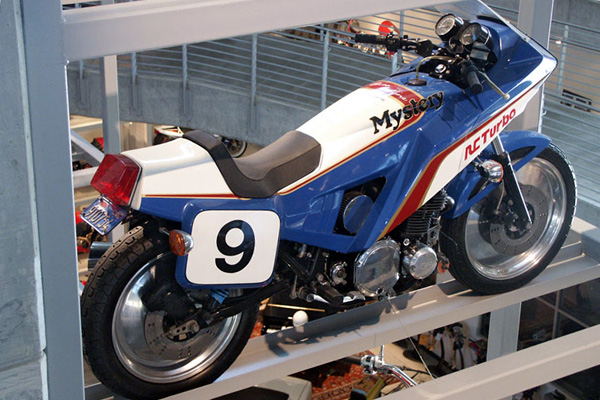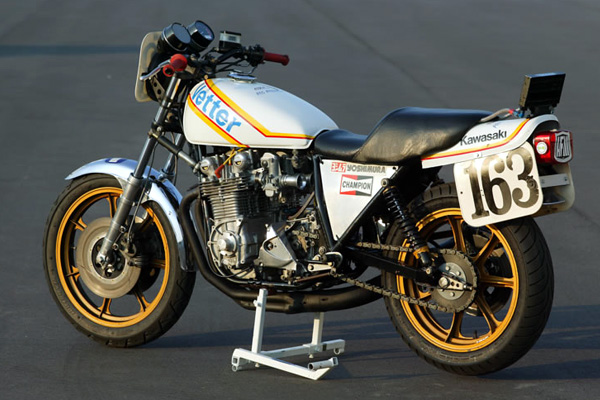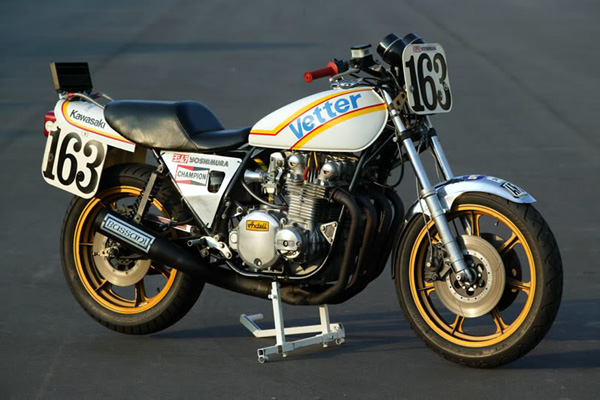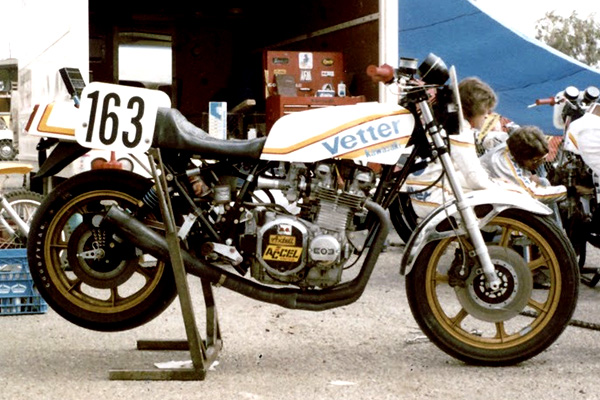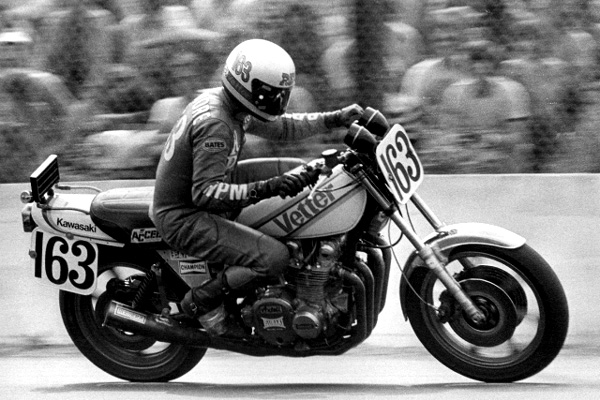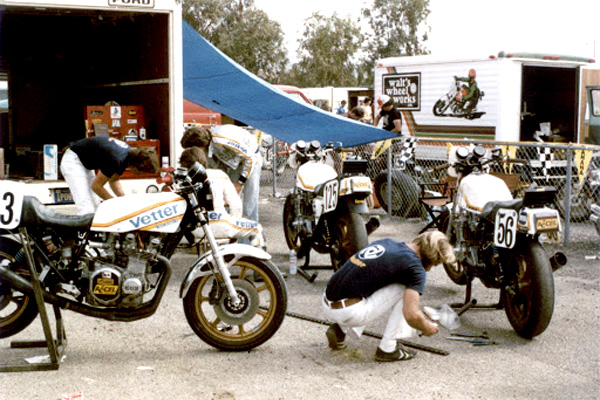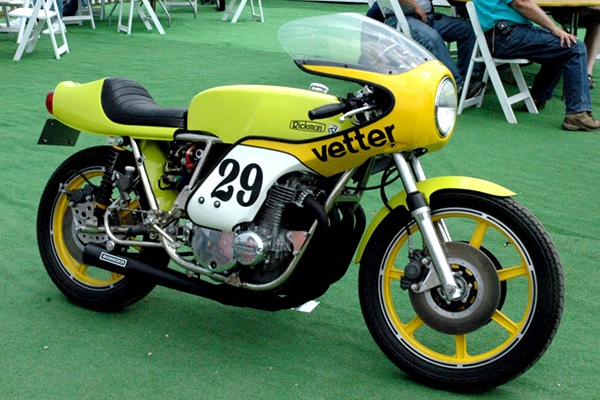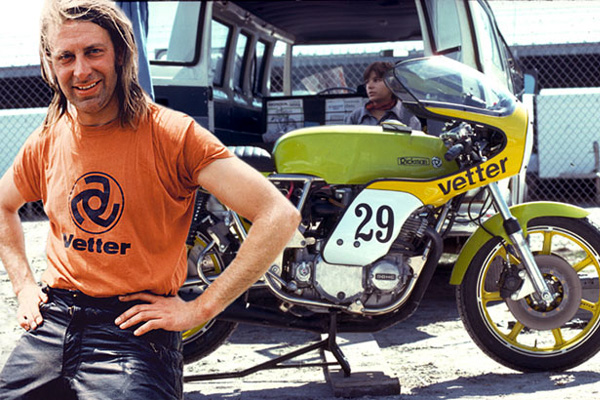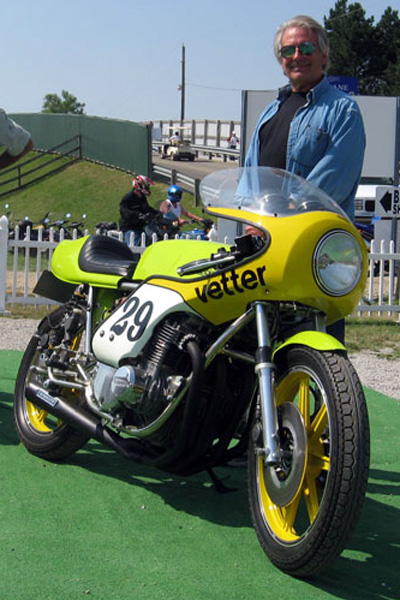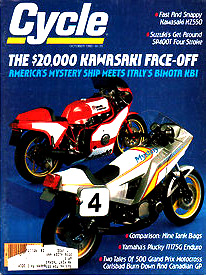

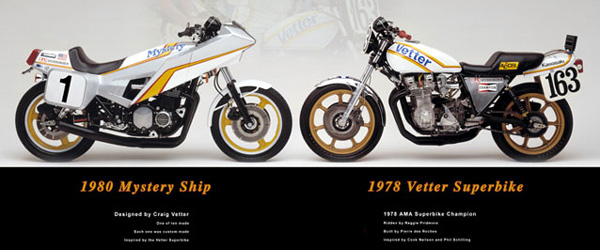
1980 Mystery Ship Craig Vetter's Limited-Edition Rolling Artwork The late 1970s were heady times for motorcycle innovator Craig Vetter. The man who had changed the motorcycling world with his line of Windjammer fairings in the f70s sold that successful company in 1978, and moved on to other pursuits. That year, he sponsored two-time AMA Superbike Champion Reg Pridmore on the road-race circuit, and the combination resulted in a third straight title for Pridmore. But Vetter wasnft just looking for a championship. He also used the team to develop concepts for a project he called the Mystery Ship. The Mystery Ship would be a limited-production streetbike, or what Vetter referred to as ga streetable road-racer, with all the right parts.h To create the bike, Vetter took a stock Kawasaki KZ1000 and disassembled it. He removed all the unneeded tabs and brackets from the frame and welded on struts and gusseting to strengthen the structure. He also bolted on a box-section swingarm for strength and installed glaid-downh shocks for more travel and progressive action. The wheels were magnesium Dymags, the hot ticket of the era. The gas tank held 6 gallons, the maximum allowed in AMA Superbike racing. Rearset pegs and a Yoshimura four-into-one pipe also showed the bikefs racing heritage. But what makes the Mystery Ship unique is the full bodywork, which is essentially just two pieces: the nose fairing and the body. Of course, all that hand-work didnft come cheap. While a stock KZ1000 of the time cost $3,500, Vetterfs Mystery Ship was offered at $9,995. From the beginning, the bike was planned for a limited production run. In the end, only 10 of these exclusive machines actually were built, each bearing its production number on the side number plates. Ifve never quite been sure what to make of Craig Vetter. One the one hand, hefs the man who gifted us the Triumph X-75 Hurricane and helped create the Triumph T160. On the other hand, hefs responsible for the Windjammer fairing (and worse). So is Vetter a visionary, or is he one wave short of a shipwreck? Ifm inclined to err on the side of visionary, because he designed the 1980 eMystery Shipf. Just ten of these Kawasaki KZ1000-based superbikes were built, and if you think the fiberglass styling looks outrageous today, imagine the impact it had thirty years ago. Underneath the Flash Gordon aesthetics were a reinforced and cleaned-up frame with a repositioned steering head, a new swingarm and rear suspension set-up, magnesium Dymag wheels and a Yoshimura four-into-one pipe. Itfs still a showstopper today, and youfll find a Mystery Ship in the Motorcycle Hall of Fame Museum. And talking of showstoppers, take a look at what Craig Vetter rode to the Quail Gathering. [Thanks Jonathan Whittles.] http://www.craigvetter.com/index.html Motohistory Quiz #25 We have a winner! (8/16/2006) We had a lively response to our Motohistory Quiz #25, which was a picture of the molds used to build the body for the Vetter Mystery Ship. Perhaps I included too many clues in the quiz announcement, since the words gmold,h gmystery,h gship,h and gVeteranh all appeared in the paragraph. Still, many participants recognized the image as molds and perceived that they had something to do with a Vetter project, but most did not make the connection to the Vetter Mystery Ship. The first with the correct answer was gthe man from Mars,h Paul Danik of Mars, Pennsylvania. Dave Price of Dunstable, Massachusetts, a frequent participant in the Motohistory Quiz, came through with the correct answer literally seconds behind Paul. Others coming in later with correct answers were Larry Maiers, Ed Alf, and David Edwards. Paul will get a very special prize for winning this one, an autographed original Mystery Ship catalog (pictured here), donated by Craig Vetter himself. And I am going to send Dave Price a Motohistory cap for missing the win by only seconds. Yeah, I know that's not how it's done in racing; you're either first or you're a looser. But I'm a soft touch. As for you other guys, keep reading Motohistory and playing the quiz. I can't afford to give caps to everyone (and besides, Larry Maiers already has one if he hasn't lost it). The Vetter Mystery Ship (pictured with Vetter below) signaled the culmination of the first phase of Craig Vetter's career as an influential motorcycle designer. He had already helped revolutionize touring with his Windjammers, and he hoped to have a similar influence on the emerging sport bike market with a new fairing called the Quicksilver, which looked much like the nose of the Mystery Ship. The project was already well along when Craig sold his company in 1978, and as a term of that sale he was not allowed to compete with the new owners. This meant that he was effectively taking himself out of the motorcycle product design business, except that he was allowed to complete the Mystery Ship project. It was unveiled on June 4, 1980. The Vetter Corporation sponsored Reg Pridmore to AMA road racing championships in 1978 and 1979, and it was Craig's desire to incorporate into the Mystery Ship some of the things his team had learned at the track, combining performance with comfort in a new superbike for the street. It's name was borrowed from the Travel Air Mystery Ship, a revolutionary aircraft that introduced in 1929 the modern era of low-wing design. Pierre DesRoches helped develop the race-tuned chassis for the Vetter Mystery Ship, and Pops Yoshimura was recruited to build engines to each customer's specifications. For the gtoo much is not enoughh customer, Russ Collins would build a turbocharged version. Only ten Mystery Ships were built, and the whereabouts of nine are known today. The #1 prototype was donated by Craig Vetter to the Motorcycle Hall of Fame Museum. For more about Vetter design, click here. All photos provided by Craig Vetter. This 1980 Kawasaki KZ1000 Turbo Charged Vetter Mystery Ship is Number 6 of only ten Mystery Ships produced by Craig Vetter. It is co-owned by business partners, Ron Henaghan and Dale Foley of Richmond, Virginia, USA, and is believed to be one of only two Turbo Charged versions. At the time of writing (October 2012), this motorcycle has only 2 miles on the clock, and has been stored in a climate controlled facility for its whole life. The Mystery Ship was designed as a limited production streetbike, or what Vetter referred to as "a streetable road racer, with all the right parts." Ron and Dale still have the original purchase order form for the motorcycle, along with all documented paperwork. 1980 Vetter Mystery Ship #1. Photograph by Frank Bez. Just like the standard motorcycles in Kawasaki's Z1 range, the 1980 Vetter Mystery Ship is a motorcycle that still looks stunning today..... ....but this time, the credit for the styling goes to Craig Vetter. Mystery Ship #1 shown in the photograph above has been donated by Craig Vetter to the American Motorcyclists Association Hall of Fame Museum in Ohio. Click the photograph to visit Craig's website. The Mystery Ship was based on the 1980 Kawasaki KZ1000 MKII. They cost $9,995 in 1980 when a stock KZ1000 MKII cost around $3,500. Standard KZ1000 MKII frames were used, however, they had several modifications. They were taken to Kosman's where a frame jig was used to ensure accuracy, as the geometry of the Mystery Ship frames was to be the same as the Kawasaki KZ1000 racing motorcycle sponsored by the Vetter Corporation in the 1978 AMA Superbike Series. (further information in the Brief History below) The steering headstock was removed completely. It was replaced at 26 by a machined headstock fitted with 62mm tapered bearings. The frames were strengthened, and all brackets that were not needed were removed. Rearset footpegs and a gear change linkage system were fitted. A shortened rear brake lever was used. The mounting points for the Mulholland Force 1 rear shock absorbers were relocated further down the frame. A box section swing arm was fitted. 3 spoke magnesium Dymag wheels were fitted with Michelin tyres, M45 front and M48 rear. Standard Kawasaki brake discs and calipers were used with Ferodo pads. A four into one Yoshimura exhaust system was fitted. The bodywork was a two piece unit that covered a 6 US gallon fuel tank. A Lockhart oil cooler was fitted into the nose of the fairing just below the headlight. The Vetter Mystery Ship came supplied with a standard KZ1000 MKII engine which, according to Yoshimura, produced around 75 BHP at 9,000rpm, however, for those with a deeper wallet, several Yoshimura tuning options were offered. Stage I. $799. 1105cc with 10,000rpm cam. (101 HP) Stage II. $1134. As above but with 10,500rpm cam with ported and polished head. (108 HP) Stage III. $1348. As Stage II but with larger valves. (116 HP) Stage IV. Superbike specification. Prices were available on application. For those wanting a Turbo Charged option, for around $1,700, Vetter would work with Russ Collins of R.C. Engineering. Left: A comparison of the Kawasaki engined Bimota KB1 and the Vetter Mystery Ship was featured in the October 1980 issue of "Cycle" magazine. Right: Craig Vetter with the Vetter Mystery Ship. It was originally planned that 200 Mystery Ships would be built, however, Craig Vetter had a hang glider crash which forced him to stop production after only 10 Mystery Ships had been built, so a Mystery Ship is a rare motorcycle. Whilst recovering from his accident, Craig began to reflect on what he felt was more important. Although the Mystery Ship had been an important development, he decided to turn his efforts to bringing attention to fuel economy with the development of his Streamliner, a subject he has remained passionate about to this day. "What does it really take to push a person down the road at 55mph?".....Craig Vetter A Brief History of Craig Vetter and The Vetter Corporation. Craig Vetter was born in 1942 in Alabama. He moved with his family to Illinois when his father retired from the US Air Force. After riding motorcycles on long journeys, Craig realised that it would be much more pleasant to ride if there was some protection from the wind and weather. Craig also knew that fuel economy would be improved if wind resistance could be reduced. He became fascinated by motorcycle fairing design, and started to experiment with various designs. He went on to form The Vetter Corporation and sold his first range of fairings in 1966. Craig has always had a passion for British motorcycles, and in 1969, he created a design that was originally based on the BSA Rocket 3 motorcycle, however the design eventually became known as the X-75 Triumph Hurricane. Vetter is perhaps best known for Windjammer Fairings that were introduced in 1971. Luggage Systems to match the Windjammer Fairings were introduced in mid 1978. In the mid 1970s, Craig Vetter rode Rickman framed Kawasakis in several races. He was not just after race wins. The purpose was to develop his own ideas for a racing motorcycle. 1976 was the first year of the AMA Superbike Series. The Series was won by Reggie Pridmore riding a BMW R90S. In 1977, Reggie won the Series again, this time riding a Racecrafters Kawasaki KZ1000 tuned by Pierre des Roches. In 1978, the Vetter Corporation sponsored Reggie to ride in the AMA Superbike Series. The Team Vetter motorcycle was also a Kawasaki KZ1000 tuned by Pierre des Roches. Reggie won the Series for the third time in a row. The 1978 Team Vetter KZ1000 Superbike, along with Craig's earlier experience on the Rickman Kawasakis, led to the design of the Mystery Ship. In November 1978, Craig Vetter sold the Vetter Corporation and moved to Carmel, California with his wife Carol and two sons, Zak and Morgan. Craig Vetter was inducted into The AMA Motorcycle Hall of Fame in 1999. Craig Vetter with the X-75 Triumph Hurricane and the Vetter Mystery Ship at an AMA Motorcycle Hall of Fame Museum Event in 2011 Click the photograph to visit the AMA website. Craig still remains active in the motorcycle world and is involved in many projects involving improvements in motorcycle fuel economy. Visit www.craigvetter.com for more information. I would like to thank Craig Vetter for his permission to use the photographs on this page and for providing me with information about the Vetter Mystery Ship.
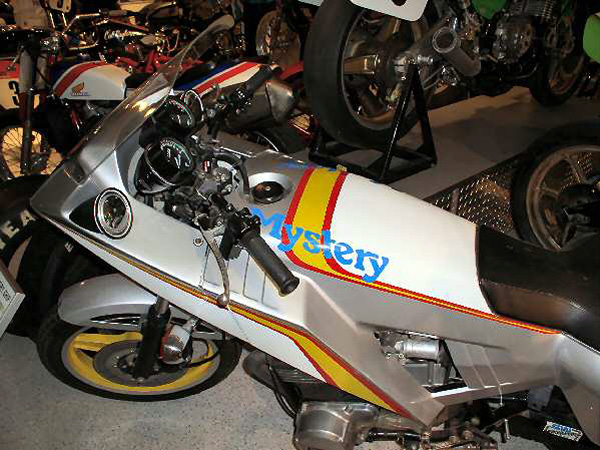
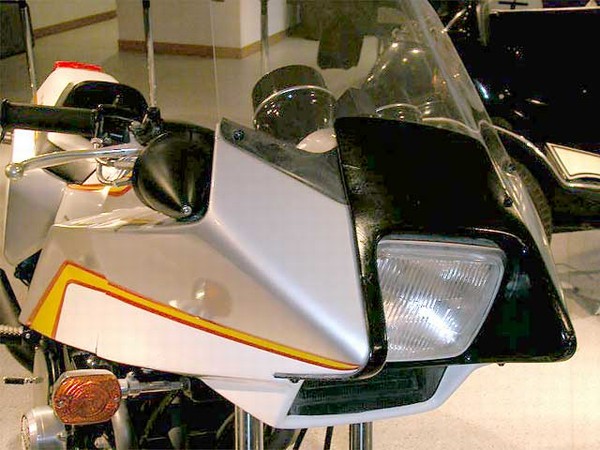
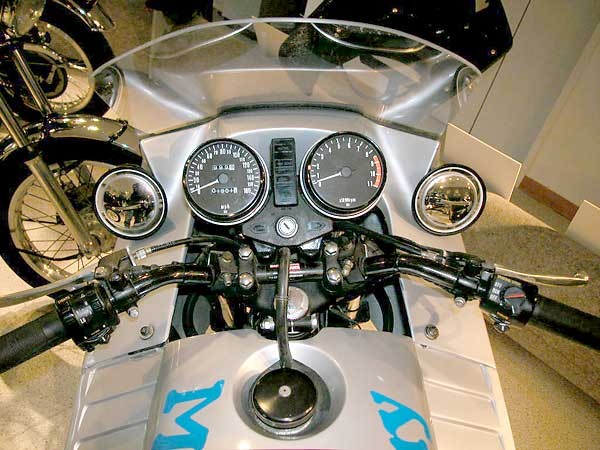
#1
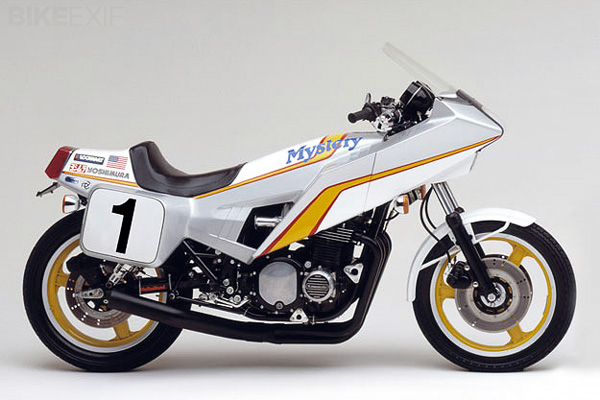
#5
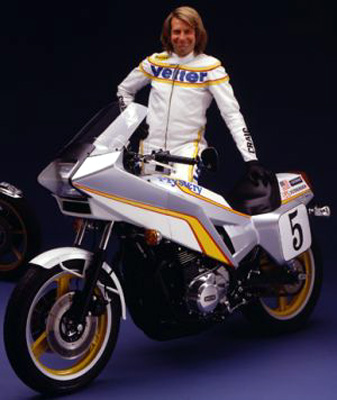
#6
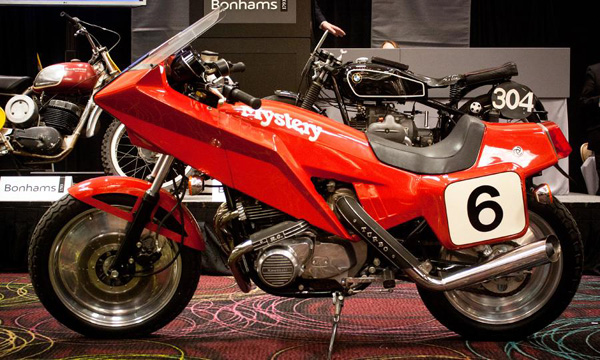
#7
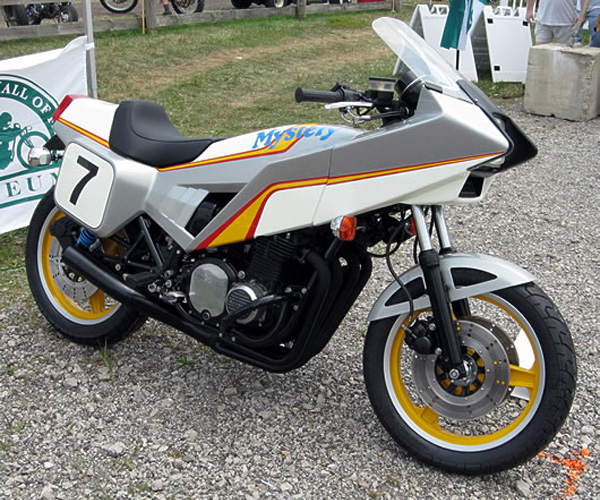
#9
